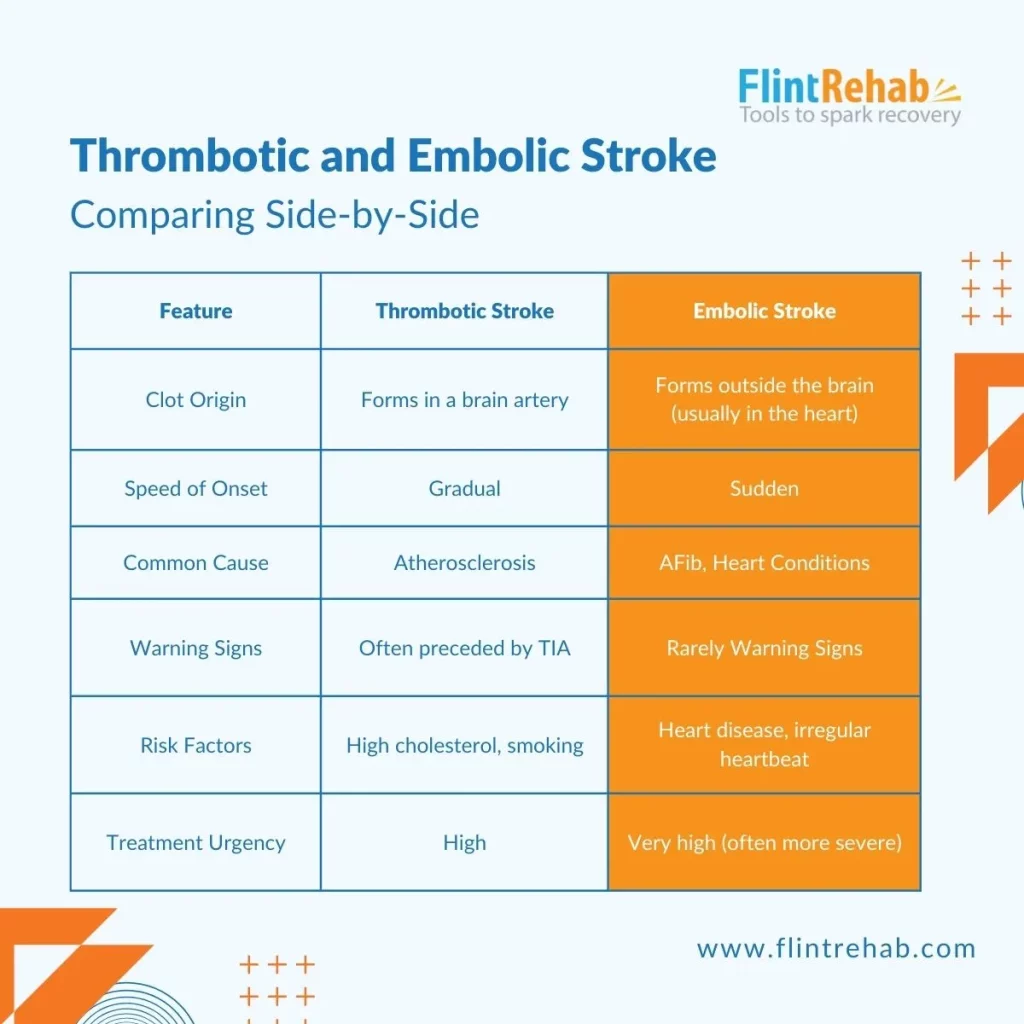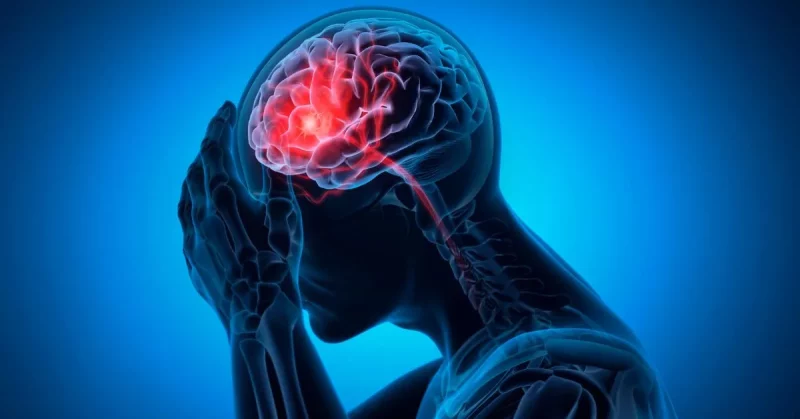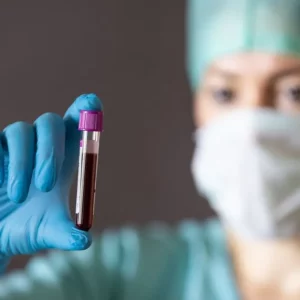When it comes to strokes, most people are familiar with the term “ischemic stroke.” But within that category lie two distinct types: thrombotic stroke and embolic stroke. Understanding the difference between thrombotic vs embolic stroke isn’t just useful for medical professionals—it can help everyday people recognize warning signs, ask the right questions, and understand treatment options.
In this article, we’ll break down the key differences between thrombotic and embolic strokes, explore their causes, symptoms, diagnostic tools, and treatment strategies, and answer some common questions. Let’s get started.
What Is an Ischemic Stroke?
An ischemic stroke occurs when blood flow to the brain is blocked by a clot, depriving brain tissue of oxygen and nutrients. If the blockage lasts for more than a few minutes, brain cells begin to die—leading to lasting neurological damage or death. Ischemic strokes are the most common type of stroke, accounting for approximately 87% of all cases.
Thrombotic and embolic strokes are both ischemic strokes, but they differ in where the clot forms and how it travels.
Thrombotic Stroke: A Clot at the Source
A thrombotic stroke happens when a blood clot (thrombus) forms directly in one of the arteries supplying blood to the brain. It usually develops gradually and is often linked to atherosclerosis, or hardening of the arteries.
What Is a Thrombotic Stroke?
A thrombotic stroke happens when a clot develops within an artery in the brain, gradually narrowing and then fully blocking blood flow. These clots usually form over an area of plaque buildup — a process called atherosclerosis.
There are two types of thrombotic stroke:
- Large-vessel thrombosis: Affects major arteries like the carotid or vertebral arteries.
- Small-vessel thrombosis (lacunar stroke): Affects smaller, deeper arteries inside the brain.
Common Risk Factors for Thrombotic Stroke
Thrombotic strokes often develop over time and are linked to chronic health conditions, including:
- High blood pressure (hypertension)
- High cholesterol
- Type 2 diabetes
- Smoking
- Atherosclerosis
- Obesity
- Sedentary lifestyle
In addition, thrombotic strokes often occur during sleep or early in the morning, when blood pressure naturally dips and blood flow may slow. In fact, the majority of all types of strokes occur between 6 am and noon.
How Does a Thrombotic Stroke Occur
Thrombotic strokes tend to develop slowly over minutes or even hours, sometimes preceded by warning signs known as transient ischemic attacks (TIAs) or “mini-strokes.”
Over time, here is what a typical chain of events might look like for a thrombotic stroke.
- Fatty deposits (plaques) build up in artery walls.
- The artery narrows over time, gradually limiting blood flow.
- A blood clot forms at the site of the plaque.
- The clot blocks blood flow, triggering a stroke.
Warning Signs of a Thrombotic Stroke Include:
- Numbness or weakness on one side of the body
- Sudden trouble speaking or understanding
- Vision loss in one or both eyes
- Loss of coordination or balance
- Severe headache/migraine (less common in thrombotic strokes)
If you observe or are experiencing these symptoms, stop reading and dial 9-1-1 for immediate medical attention.
Embolic Stroke: A Traveling Clot
Embolic strokes tend to occur suddenly and without warning, and symptoms are usually more severe at onset compared to thrombotic strokes.
What Is an Embolic Stroke?
An embolic stroke occurs when a blood clot or other debris forms elsewhere in the body—often in the heart—and then travels through the bloodstream to lodge in a brain artery.
Unlike thrombotic strokes, embolic strokes tend to happen suddenly and without warning.
Common Causes and Risk Factors for Embolic Stroke
The most common cause of embolic stroke is atrial fibrillation (AFib) — an irregular heart rhythm that allows clots to form in the heart.
Other risk factors include:
- Heart valve disease
- Recent heart attack
- Endocarditis (infection of the heart lining)
- Patent foramen ovale (a hole in the heart)
- Deep vein thrombosis (DVT) with patent foramen ovale
Between 9 and 25 percent of all ischemic strokes are considered “embolic strokes of undetermined source”, abbreviated as ESUS. These fall within a subtype of cryptogenic strokes, which are strokes in which it is challenging to determine a precise cause.
How Does an Embolic Stroke Occur?
Think of an embolic stroke like a roadblock in your brain’s blood flow. Here’s an example of how an embolic stroke may occur:
- A blood clot forms in the heart or somewhere else in the body.
- That clot breaks loose and rides the bloodstream like a highway.
- When it reaches the brain, it gets stuck in a narrow artery.
- The blockage cuts off oxygen, and brain cells begin to die—fast.
Embolic Stroke Symptoms to Watch For
Embolic strokes come on fast—and every second counts. Although the symptoms may be very similar to a thrombotic stroke, time may be even more important as embolic strokes are often more severe and carry a higher risk of mortality.
Keep an eye out for these sudden warning signs:
- Sudden weakness or numbness, especially on one side of the body
- Slurred speech or trouble getting words out
- Blurry or lost vision, often in one eye
- Sudden confusion or trouble understanding what’s being said
- Dizziness or loss of balance
- A sudden, intense headache that feels different from usual
Comparing Thrombotic vs. Embolic Stroke Side-by-Side
Thrombotic and embolic strokes are both caused by blood clots, but they start in different places and show up in different ways.
A thrombotic stroke happens when a clot forms right in one of the brain’s arteries—usually because of plaque buildup from things like high cholesterol or smoking. These strokes tend to come on more gradually and might be preceded by a mini-stroke (called a TIA), which acts like a warning sign.
On the other hand, embolic strokes are more sudden. They happen when a clot forms somewhere else in the body—most often in the heart—and then travels to the brain. Conditions like atrial fibrillation or other heart problems are common causes.
While both types are serious and need fast treatment, embolic strokes are often more urgent due to their sudden and severe nature. Check out the chart below for a quick side-by-side comparison:

Diagnosis: How Doctors Tell the Difference Between Thrombotic vs Embolic Stroke
A proper diagnosis is critical for choosing the right treatment. Here’s how healthcare professionals distinguish between thrombotic and embolic strokes:
Medical History & Physical Exam
- Risk factors like heart disease or atherosclerosis help point toward embolic or thrombotic causes.
- Onset patterns (sudden vs gradual) also provide clues.
Imaging Tests
- CT scan: Detects bleeding and major stroke areas.
- MRI: Provides detailed views of brain tissue.
- CT angiography or MR angiography: Shows blood vessel structure.
Additional Tests
- Carotid ultrasound: Detects plaque in neck arteries (linked to thrombotic stroke).
- Echocardiogram: Checks for clots or abnormalities in the heart (for embolic stroke).
- Electrocardiogram (ECG): Detects irregular heart rhythms like atrial fibrillation.
Treatment Options
Treatment options for thrombotic and embolic stroke will depend on the individual and their medical history. However, let’s take a look at some of the common options for each.
Emergency Treatments for Thrombotic and Embolic (Both Types)
For either stroke type, time is critical. Treatments aim to restore blood flow and minimize brain damage.
- tPA (tissue plasminogen activator): A clot-busting drug that must be given within 3–4.5 hours of symptom onset.
- TNK (Tenecteplase): Another clot busting drug that should be administered within hours of stroke occurrence via single IV injection.
- Mechanical thrombectomy: A procedure to physically remove the clot, often used for large artery blockages.
Thrombotic Stroke Treatment
- Aspirin or antiplatelet therapy: Prevents further clot formation.
- Statins: Lower cholesterol and stabilize plaques.
- Lifestyle changes: Smoking cessation, dietary changes, and exercise.
Embolic Stroke Treatment
- Anticoagulants (blood thinners): Such as warfarin or direct oral anticoagulants (DOACs), especially for patients with atrial fibrillation.
- Heart rhythm management: Medications or procedures to treat atrial fibrillation or other arrhythmias.
- Addressing cardiac sources: Repairing heart valves or closing heart defects when needed.
Thrombotic vs Embolic Stroke: Common Questions
Can you have both types of stroke?
Yes. Some individuals may have mixed mechanisms, such as an embolic stroke on top of pre-existing atherosclerosis. Proper diagnostics are essential for effective treatment.
Is a thrombotic or embolic stroke more dangerous?
Both types are serious and can be life-threatening. Embolic strokes tend to be more sudden and severe and often have a higher mortality rate, but thrombotic strokes may cause more gradual brain damage due to repeated TIAs.
Are TIAs always a warning sign for thrombotic stroke?
Not always—but TIAs are more common before a thrombotic stroke. If you experience symptoms that go away within minutes or hours, don’t ignore them. They’re a red flag, as 1 in 5 individuals who’ve had a TIA experience a stroke within the following year.
How is atrial fibrillation related to embolic strokes?
Atrial fibrillation causes irregular heartbeats, which can lead to blood pooling and clot formation in the heart. These clots may break free and travel to the brain, causing an embolic stroke.
Can younger people have embolic or thrombotic strokes?
Yes. While stroke is more common with age, young adults can suffer from either type—especially those with congenital heart conditions, autoimmune disorders, or lifestyle-related risk factors.
Embolic vs Thrombotic Stroke Outlook
Whether you’re a caregiver, a stroke survivor, or simply someone looking to be more informed about stroke, understanding the difference between embolic and thrombotic strokes can have a meaningful impact. These two types of ischemic stroke may differ in how they form and present, but they both require the same urgency when it comes to recognition and treatment.
The takeaway? Knowledge is power — especially when it comes to stroke. Stay alert, stay informed, and stay proactive. It could make all the difference.









